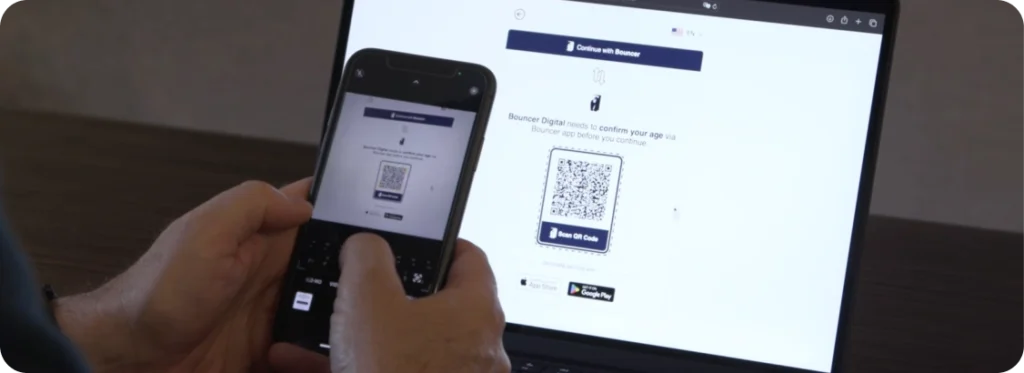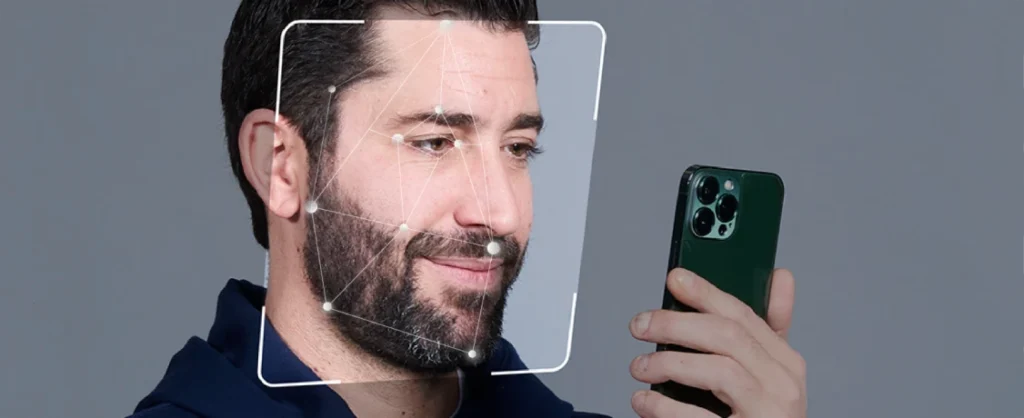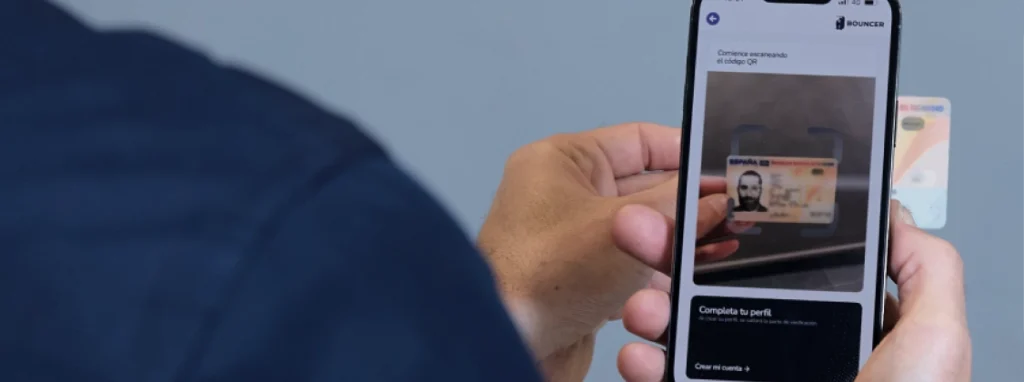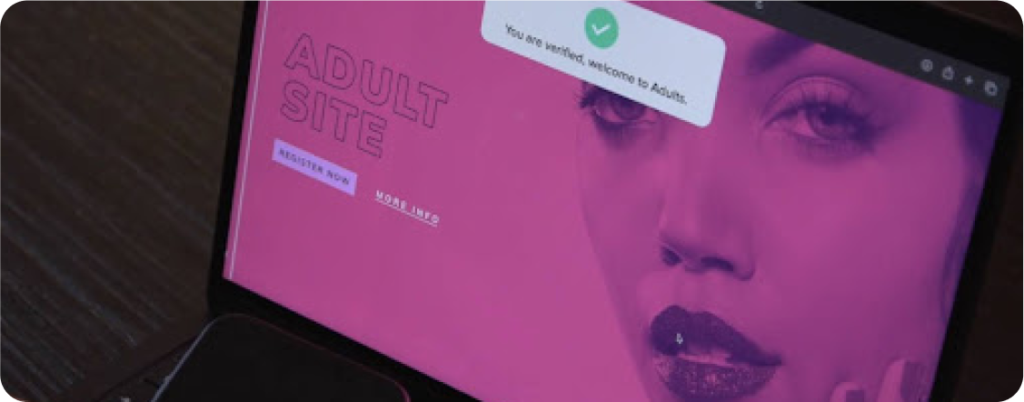Protect your online business and stay compliant with Bouncer's effective anonymous age verification so your users can safely browse restricted content.
Protect your online business and stay compliant with Bouncer's effective anonymous age verification so your users can safely browse restricted content.
Scan the QR
Scan the QR code with your cell phone to verify your age and access restricted content or products.

Scan your face
Place your face in front of the camera, follow the instructions for facial recognition and through Artificial Intelligence we will verify your age.

Scan your ID*
In case the AI cannot estimate your age automatically, a scan of an official document will be requested to complete the verification process.

Get access to your adult product, service or content!
Once you have completed the above steps, you will receive an immediate confirmation that your access has been successfully verified.

Our value

Ensures legal compliance with robust age verification solutions designed for adult content

Protects user privacy through secure data handling practices

Facilitates access to adult-restricted content while minimizing the risk of access by minors

Trusted by leading adult content platforms for seamless integration and reliability





Unlocks secure access for users in more than 180 countries
Bouncer is at the forefront of age verification technology globally, ensuring safe and compliant access to adult content. Our advanced database and documents support seamless verification worldwide, allowing legitimate users to enjoy unrestricted access while keeping out unauthorized viewers.

Federal Telecommunications Law
The Federal Law requires sites with adult content to
implement strict age verification measures
for users.
Business and Commerce Code
Texas law requires digital service providers to
digital service providers
record the age of their users and obtain parental
obtain verified parental consent for minors.
parental consent for minors.
Child Online Protection Act
In Arkansas, sites with adult content
must implement robust systems to verify the age of
the age of users and prevent access by minors.
Verification of Age Act
In Indiana, operators of websites with adult
content are with adult content are required to
conduct a reasonable age verification check to
protect minors.
Controlling Access to Adult Content Act
Regulations in Mississippi require websites
with material deemed harmful to minors
to adopt age verification measures
for visitors.
Internet Youth Protection Act
Montana states that sites with adult content must
apply rigorous age controls to ensure that
users are of legal age.
Child Internet Safety Act
In North Carolina, there is a demand that
adult content platforms are required to
verify the age of users before granting them access to
before granting them access to the content.
Law for the Protection of Minors in
Social Platforms
Utah has implemented a law that requires
social platforms to establish age verification
systems in order to safeguard minors.
Age Verification and Protection of
Minor Act
In Virginia, sites with adult content
must conduct an effective age verification check for all
age verification for all users accessing their platform.
Preliminary draft of the Organic Law for the
protection of minors in digital environments
In Spain, a regulation will be implemented
that will guarantee a safe digital environment
for children, protecting minors from risks
such as inappropriate content cyberbullying and fraud,
while promoting positive conscious use of technology.
Online Safety Bill 2024
The United Kingdom requires all adult content
platforms to adult content platforms to verify
the age of users to comply withonline safety law.
Digital Services Act & Regulation
(EU) 2022/2065
The Digital Services Act requires platforms to verify
age to limit minors' access to adult content.

Federal Telecommunications Law
The Federal Law requires sites with adult content to
implement strict age verification measures
for users.
Business and Commerce Code
Texas law requires digital service providers to
digital service providers
record the age of their users and obtain parental
obtain verified parental consent for minors.
parental consent for minors.
Child Online Protection Act
In Arkansas, sites with adult content
must implement robust systems to verify the age of
the age of users and prevent access by minors.
Verification of Age Act
In Indiana, operators of websites with adult
content are with adult content are required to
conduct a reasonable age verification check to
protect minors.
Controlling Access to Adult Content Act
Regulations in Mississippi require websites
with material deemed harmful to minors
to adopt age verification measures
for visitors.
Internet Youth Protection Act
Montana states that sites with adult content must
apply rigorous age controls to ensure that
users are of legal age.
Child Internet Safety Act
In North Carolina, there is a demand that
adult content platforms are required to
verify the age of users before granting them access to
before granting them access to the content.
Law for the Protection of Minors in
Social Platforms
Utah has implemented a law that requires
social platforms to establish age verification
systems in order to safeguard minors.
Age Verification and Protection of
Minor Act
In Virginia, sites with adult content
must conduct an effective age verification check for all
age verification for all users accessing their platform.
Preliminary draft of the Organic Law for the
protection of minors in digital environments
In Spain, a regulation will be implemented
that will guarantee a safe digital environment
for children, protecting minors from risks
such as inappropriate content cyberbullying and fraud,
while promoting positive conscious use of technology.
Online Safety Bill 2024
The United Kingdom requires all adult content
platforms to adult content platforms to verify
the age of users to comply withonline safety law.
Digital Services Act & Regulation
(EU) 2022/2065
The Digital Services Act requires platforms to verify
age to limit minors' access to adult content.
Consolidated Industry Codes
In Australia, certain online
services are required to implement
age verification to restrict minors'
access to adult content.

©2025 bouncer DIGITAL
Digital Services Act & Regulation (EU) 2022/2065
The Digital Services Act requires platforms to verify age to limit minors’ access to adult content.
Preliminary draft of the Organic Law for the protection of minors in digital environments
In Spain, a regulation will be implemented that will guarantee a safe digital environment for children, protecting minors from risks such as inappropriate content cyberbullying and fraud, while promoting positive conscious use of technology.
Online Safety Bill 2024
The United Kingdom requires all adult content platforms to adult content platforms to verify the age of users to comply withonline safety law.
Business and Commerce Code
Texas law requires digital service providers to digital service providers record the age of their users and obtain parental obtain verified parental consent for minors. parental consent for minors.
Child Online Protection Act
In Arkansas, sites with adult content must implement robust systems to verify the age of the age of users and prevent access by minors.
Verification of Age Act
In Indiana, operators of websites with adult content are with adult content are required to conduct a reasonable age verification check to protect minors.
Controlling Access to Adult Content Act
Regulations in Mississippi require websites with material deemed harmful to minors to adopt age verification measures for visitors.
Internet Youth Protection Act
Montana states that sites with adult content must apply rigorous age controls to ensure that users are of legal age.
Child Internet Safety Act
In North Carolina, there is a demand that adult content platforms are required to verify the age of users before granting them access to before granting them access to the content.
Law for the Protection of Minors in Social Platforms
Utah has implemented a law that requires social platforms to establish age verification systems in order to safeguard minors.
Age Verification and Protection of Minor Act
In Virginia, sites with adult content must conduct an effective age verification check for all age verification for all users accessing their platform.
Federal Telecommunications Law
The Federal Law requires sites with adult content to implement strict age verification measures for users.
Where can our technology be used?
Bouncer Digital’s age validation technology can be applied in a variety of industries and sectors to ensure compliance with age-restricted content or product access regulations and ensure the safety of minors in the digital environment:
Privacy and Data Protection
Bouncer Digital’s facial age estimation does not involve the processing of biometric data for identification purposes. Our system does not allow unique identification of a person, but merely estimates age from facial characteristics. This ensures that personal data is not processed or stored in an irregular manner. We do not store or share images, and data is never sold or transferred to third parties.
Compliance and Regulations
Bouncer Digital is committed to compliance with international data protection and privacy regulations. Our technology is designed to meet the standards set forth in various global regulations, such as the European Union’s General Data Protection Regulation (GDPR) and privacy by design principles.
In addition, our technology follows international best practices in terms of privacy protection and data minimization in decision making to perform age validation.
Specifically, Bouncer Digital conforms to the following technical and regulatory standards:
In Bouncer Digital we have developed a technological solution that is fully compatible with the age verification regulations required in different countries and complies with the principles of Privacy and Data Protection.
How it works
Bouncer Digital’s facial age verification technology allows estimating a person’s age in real time using a process of biometric analysis and liveness check.
Bouncer employs advanced artificial intelligence algorithms to analyze facial features in order to estimate a person’s age. The technology is highly accurate in the biometric analysis of the user, 99.5% effective, and is performed anonymously, fairly and impartially, regardless of gender, race or skin tone.
Bouncer complies with the principle of “privacy by default” and “data minimization”, which means that we use the technology for the sole purpose of validating the user’s age of majority and not storing any data from the process.